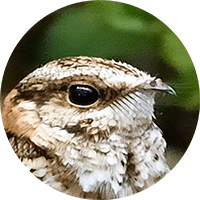White-tailed Nightjar
The White-tailed Nightjar (Hydropsalis cayennensis) Read in Spanish
Appearance: The White-tailed Nightjar is a medium-sized bird with cryptic plumage for camouflage. It has a mottled brown, gray, and white plumage that helps it blend in with its environment. This species is named for the white patches on its outermost tail feathers.
Habitat: The White-tailed Nightjar is typically found in a variety of habitats, including open woodlands, savannas, grasslands, and forest edges. It inhabits both lowland and montane regions, with a preference for areas with sparse vegetation. This species can be found across different regions of Colombia, from coastal areas to the Andes and the Amazon basin.
Behavior: Like other nightjars, the White-tailed Nightjar is nocturnal, being most active at dawn and dusk. It is an insectivorous bird, feeding on a variety of flying insects such as moths, beetles, and flying ants. White-tailed Nightjars are known for their aerial foraging behavior, catching insects on the wing with their wide mouths.
Breeding: Breeding usually occurs during the wet season when insect populations are abundant. White-tailed Nightjars lay their eggs on the ground in open areas, often using minimal nesting material. The female typically incubates the eggs while the male assists in territorial defense and providing food for the female and young.
Conservation Status: The White-tailed Nightjar is generally considered to be of Least Concern in terms of global conservation status.
Distribution
The White-tailed Nightjar (Hydropsalis cayennensis)
Andean Region: The Andean region of Colombia, with its diverse elevations and habitats, provides suitable conditions for the White-tailed Nightjar. This species can be found in the Andean foothills, valleys, and open woodlands at varying altitudes within the Andean mountain ranges in Colombia.
Caribbean Region: The Caribbean region of Colombia, including coastal areas and nearby lowland habitats, is another region where the White-tailed Nightjar is known to occur. These birds can be found in open woodlands, savannas, and grasslands in the Caribbean region.
Orinoco Region: In the Orinoco region of Colombia, which includes savannas and wetlands, the White-tailed Nightjar can be observed in suitable open habitats. Wet grasslands, riverine areas, and sparse woodlands in the Orinoco region provide suitable foraging and nesting grounds for this species.
Taxonomy
The White-tailed Nightjar (Hydropsalis cayennensis)
- Kingdom: Animalia
- Phylum: Chordata
- Class: Aves (Birds)
- Order: Caprimulgiformes
- Family: Caprimulgidae
- Genus: Hydropsalis
- Species: Hydropsalis cayennensis
Vocalization
The White-tailed Nightjar (Hydropsalis cayennensis)
- Song: The song of the White-tailed Nightjar is a series of descending, whistled notes that are repeated at intervals. The song is often described as a rhythmic "churring" or "bouncing ball" sound that can carry over long distances in the stillness of the night.
- Churring Call: The primary vocalization of the White-tailed Nightjar is a churring call, which consists of soft, rolling sounds that increase and decrease in intensity. This churring call is often delivered in a repetitive pattern and can be heard echoing across open habitats where these birds are active.
- Clapping Wings: In addition to vocalizations, the White-tailed Nightjar may produce non-vocal sounds such as clapping wings during display flights. The sound of the wings clapping together creates a distinctive noise that accompanies their aerial displays during courtship rituals.
- Contact Calls: White-tailed Nightjars may also use softer, more subdued contact calls to communicate with mates or chicks during nesting and foraging activities. These contact calls are often used for maintaining contact with family members or signaling to one another in their nocturnal environment.




